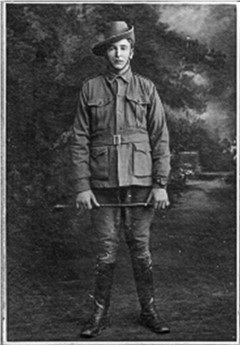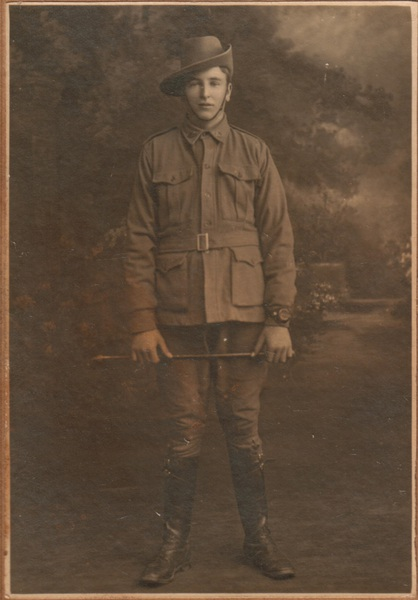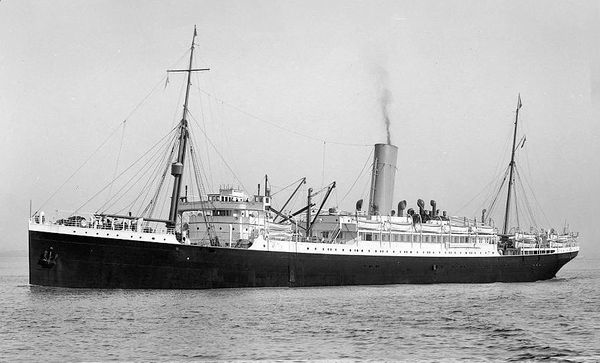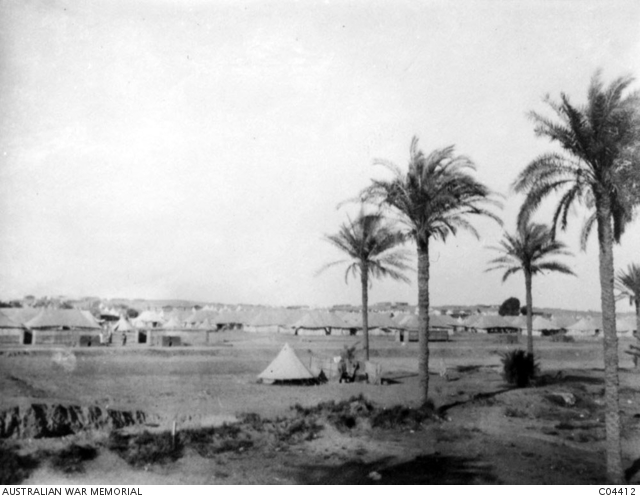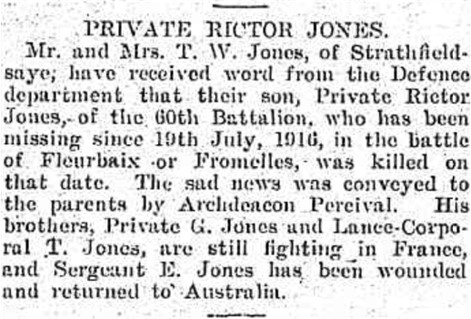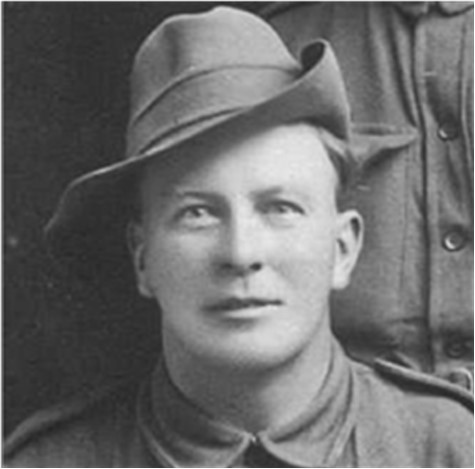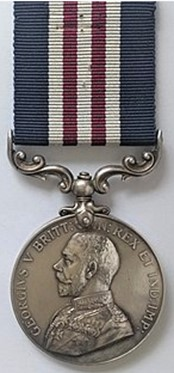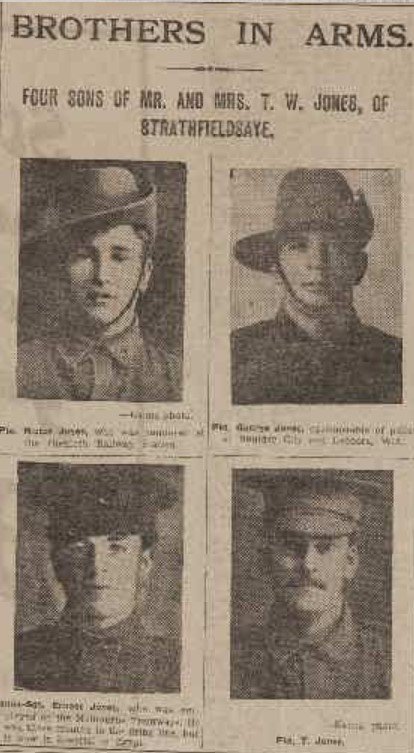Rictor JONES
Eyes blue, Hair light brown, Complexion fair
The Jones Family - Doing their Bit for the Empire
Can you help us identify Rictor?
Rictor “Ric” Jones was killed in Action at Fromelles. As part of the 60th Battalion, Ric was last seen near the german 1st line trenches. There is a chance he might be identified, but we need help. We are still searching for suitable family DNA donors.
In 2008 a mass grave was found at Fromelles, a grave that the Germans dug for 250 (Australian) bodies they recovered after the battle.
If you know anything of contacts here in Australia or his relatives from Rictor, please contact the Fromelles Association.
See the DNA box at the end of the story for what we do know about his family.
The Jones Family
The Jones’ are a large family who lived in Strathfieldsaye VIC, just outside of Bendigo. At the ripe old age of 17, Letitia Lewis married Thomas William Jones, who was also Bendigo born and bred (Bendigo was previously named Sandhurst). Letitia’s family had been living in the area since the early 1850’s. Letitia then spent the next 25 years bearing 15 children, two of which died young. She would have been used to a large family, as she was one of 9 children.
From various family records, it was a close and industrious family. All the children went to the Strathfieldsaye Public school. Strathfieldsaye was named after a migrant ship.
Thomas was involved in building bridges for the Victorian Railways and all the boys were noted as being very good axemen and bushmen, skills obviously learned from their father. Rictor’s (Ric) brother Sam was described as typical of all the boys, with a generous and good nature and also noted for his strict ideas of honesty. The boys were good athletes. Ric’s sister Letitia also described him as being a very handsome chap and a very good dancer.
Typical of the time, Liz, the eldest daughter, had to leave school early to help out with the children who kept arriving every other year. When the finances got hard, she also took on a job as a domestic at a salary of 80 cents a week, in today’s money. As with her brothers and sisters, she was known being a great help, generous and had many friends.
Four of Thomas and Letitia’s nine sons served in the War – Ric, George, Ernest and Thomas, enlisting between the ages of 18 and 32.
Ric
Like his brothers, Ric was a good sized man, 5’ 10 ¼ “. He was only 18 when he enlisted on 10 July 1915 and he still needed his parents’ permission, which they gave.

He did his training at the Bendigo Depot and embarked from Melbourne for the month long trip to Egypt on HMAT Demosthenes just after Christmas 1915.
Ric did have one particularly interesting part to his trip. During their stop in WA, when he was on a training march, he came across his brother William, whom he had not seen since 1903! Even in 1915 it was a “small world”.
After arriving in Egypt, with the casualties at Gallipoli and the many new recruits coming in from Australia, major reorganizations were underway and Ric was reassigned to the newly formed 60th Battalion. It was made up of Gallipoli veterans from the 8th Battalion, a predominately Victorian unit, and new recruits from Victoria. Two days after his reassignment he came down with mumps and was off to hospital in Tel el Kebir for about two weeks.
The new battalion did their initial training at Tel-el-Kebir. While there they were inspected by H.R.H. the Prince of Wales. In late March, they had a two day, 50 km march in the desert heat from Tel el Kebir to Ferry Post, near the Suez Canal. While there, they continued training and guarding of the Canal. They remained at Ferry post until 1 June. The time in Egypt was not all work, however. A 5th Division Sports Championship was held on 14 June, which was won the by the 60th’s brigade.
On 17 June they received orders to begin the move to the Western Front and the 60 officers and 975 enlisted men of the 60th were on trains to Alexandria and then boarded the transport ship Kinfauns Castle. After a stop in Malta, they arrived in Marseilles on 29 June and were then put on trains to Steenbecque, France getting there on 2 July 1916. On the 7th they began their move to the front, arriving in Sailly on the 9th. Now just a few kilometres from the front, their training continued, although with a higher intensity, I’m sure.
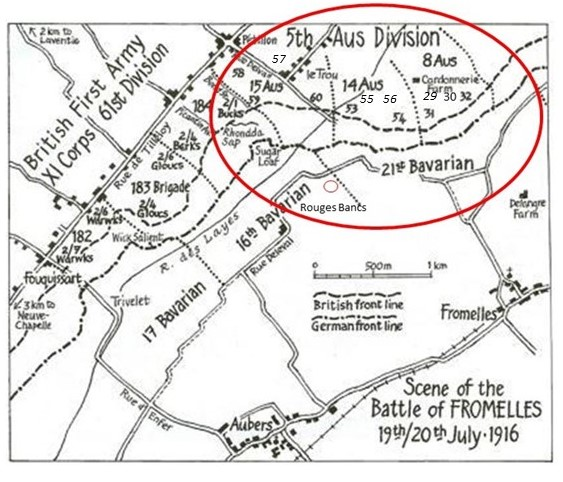
Ric was into the trenches for the first time on 14 July. The 60th were given a very difficult position for the battle, directly across from the “Sugar Loaf” salient, a heavily manned position with many machine guns. Fire from here could enfilade any troops advancing towards the front lines, giving the Germans a significant advantage. If the Sugar Loaf could not be taken, the Australian advances would also be subjected to counterattacks from that direction.
On 17 July, Ric’s unit was in position for an attack, but it was postponed due to unfavourable weather. There was a gas alarm while they were in the trenches, but luckily it was just that.
By 4:20 PM on 19 July, they were once again in position in the trenches readying for their attack. Artillery shelling from both sides was constant.
The first of four waves of Aussies went over the parapet at 5:45 PM, with the last wave going over at 6:00 PM. Casualties were immediate and heavy:
“they were enfiladed by machine gun in the Sugar Loaf and melted away”
It was reported that the 60th got to within 90 yards of the enemy trenches. One soldier said he:
“believed some few of the battalion entered enemy trenches and that during the night a few stragglers, wounded and unwounded, returned to our trenches.”
Nineteen-year-old Ric was one of the casualties and, as reported by Private A. Billingsley (3322), Ric’s end was tragic:
7 December 1916
I knew a V Jones quite well. He lived near Bendigo. He was in XV Pl, D Co. He died beside me during the night of July 19 at Fleurbaix. He was a tall young fair-complexioned lad of about 21 years of age. He lay about 100 yards from the German trenches, badly wounded. I gave him a drink of water. His leg was almost blown away. He must have bled to death painlessly. I am not absolutely certain as to his initials or number. We knew him as “Jonesy”. He used to be a Military Policeman at one time. (note: his brother George was the military policemen)
1 June 1917
He was originally in C Co but was transferred to D Co and was a Military Policeman. He came from Strathfieldsaye near Bendigo, Victoria. I saw him on the night of July 19th, 1916. We were in the same shell hole near the German 1st line trench at Fleurbaix opposite Fromelles Railway Station. His leg was badly shattered and he was in great pain, and begged me to get him some water which I did. He died about 45 minutes later. We lost the ground. His name was I think Victor.
Poor Ric. One can only hope that he didn’t suffer for too long. Fighting continued through the night. With known high casualties in the 60th, they were relieved by the 47th Battalion at 7 AM. Roll call was held at 9:30 AM. In the ‘Official History of the War’, C. W. Bean said:
“of the 60th Battalion, which had gone into the fight with 887 officers and men, only one officer and 106 answered the call”.
Such was the slaughter that day that many, including Ric, were originally reported as missing in action. Ric’s identity disc was not recovered by the Germans. It took a year of investigations before a court of enquiry could conclude that the missing men had actually been killed in action. While the Army was in contact with the family shortly after the battle, there was not much information to provide.
There are two letters in Ric’s service record from his mother Letitia which show how little was known and it appears the authorities even requested information from the families:
Strathfieldsaye 26.1.20
Dear Sir,
I received a form to fill up consurning (sic) my son Rictor but I am at a loss to furnish any information as I have not received any information as to his death. I have been led to believe he was suposed (sic) to be killed in action but that is all the information I have received so I would be very thankful to receive any information you could furnish.
I am sir your sincerly (sic)
Mrs L Jones
Strathfieldsaye 4.8.21
Dear Sirs,
It is with regret I have to inform you that I do not know where my son Private R Jones, No. 3544 60th Battalion was killed. I was informed he was missing 19th July 1916, then I was notified he must have been killed as they had got no trace of him since then. I have never hird (sic) any more about him only that he was fighting where the trenches had been flooded by the enemy. I believe it was near some Railway (sic) station but do not know the name of it. I have no letters that would throw any light on his death or burial nor where he was last seen alive. I had a trench card sent to me from him & it was posted on the 19th July 1916 the day he was supposed to be missing, but did not give any information where he was. I am very sorry indeed that I have nothing to throw a light on the mistry (sic) of his death & burial or I would only be two pleased to forward same. Thanking you in anticipation.
I am yours truly
Mrs Letitia Jones
(mother of deceased)
Ric, being an unidentified casualty of the Battle of Fromelles, is buried in an unknown grave.
The final impact of the battle on the 60th was that 397 soldiers were killed or died of wounds, of which 317 were not able to be identified. To date (2024), two of the missing soldiers have been identified from the mass grave that the Germans had dug which was found in 2008.
Ric was awarded the British War Medal, Victory Medal a Memorial Scroll and a Memorial Plaque. He is commemorated at:
- Panel 7a on the memorial wall at VC Corner Australian Cemetery, near Fromelles
- Panel 170 at the Australian War Memorial Canberra
- Bendigo War Memorial.
- Bendigo Great War Roll of Honor
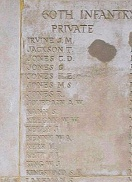
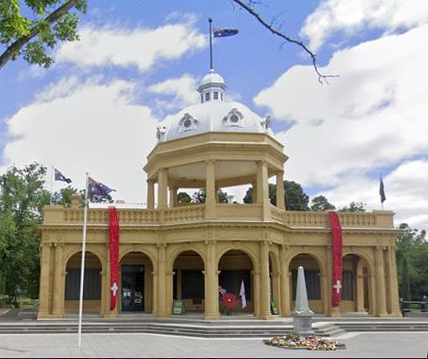
George
George was the eldest child. He was a large man for his time, 6 feet 1 ¼”, 222 pounds.
George moved to Western Australia in the early 1900s. He was also the first of the family to enlist, but in 1902 for the Boer War. Details of his service there are not known, however.
He spent some time as a miner and later became a police constable. He married Agnes Jane Skiller in Fremantle in 1905 and they had three children. In 1915 they were living in Boulder WA, in the goldfield territory close to Kalgoorlie, likely a pretty rough and ready place at the time and George would have been kept busy as a police constable.
Even though he was 32 years old and had a family, George felt the Call to War again and enlisted in the AIF on 27 August 1915. He was assigned to the 12th Battalion and did his training at the Blackboy Hill, WA. They left Australia on HMAT A31 Ajana on 22 December 1915. Not long after arriving in Egypt, he was reassigned to the newly formed 52nd Battalion. The 52nd left for France on 5 June 1916 and settled in near Fromelles.
With George’s police background and the large amount of vehicle movement in the area that urgently needed to be managed, he was assigned to Traffic Control Squad in Sailly, just days before his brother Ric arrived. With all the preparation for battle, it is unlikely that they would have been able to meet and there are no records of when he heard of Ric’s fate. He remained in this job until December.
He then had a short stint in the HQ Mining Section before rejoining the 52nd in late February 1917. He was promoted to Lance Corporal at this time.
The 52nd participated in the advance that followed the German retreat to the Hindenburg line, and attacked at Noreuil on 2 April 1917. The battalion was then involved in the Battle of Messines, in the Ypres sector of Belgium, between 7 and 12 June 1917.
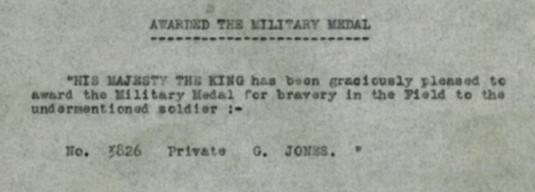
George was awarded the Military Medal, for bravery in the field. (Note, his records show he had been promoted to Corporal in September 1917, after the battles.)
The Bendigo Advertiser of 23 October 1917, reported on George’s award as follows:
Military Medal Awarded
Lance Corporal George Jones
The Military Medal has been recently awarded to Lance-Corporal George Jones, eldest son of Mr and Mrs T W Jones, of Strathfieldsaye. He is of giant stature, standing 6ft 3in in height, and being 16st 12¼lb in weight. He is unofficially reported to have qualified for the distinction by carrying into the shelter of his trench from under fire the lieutenant of his company and another man, one under each arm. Many incidents which demonstrate his great strength are related by those who knew him in WA, where he was a member of the police force for 12 years or more, during which time he was stationed at several widely separated districts, and for two years prior to enlisting for active service was stationed at Boulder. He is a South African war veteran. His wife and family reside at Northam WA.
By early October 1917, however, George had been admitted to hospital with trench foot, sufficiently bad enough to evacuate him to England, where he remained until being sent home. George returned to Australia on the HT Sardinia , disembarking on 16 December 1918 and he was discharged on 22 February 1919. Following his war service, George and his family settled on land near Busselton, Western Australia, where he lived until his death in 1935.
Ernest
Ernest, the fifth child, had jobs as a labourer, tram conductor/driver and a surveyor’s assistant. He was the first to enlist for WWI, joining on 24 March 1915, at 24 years old. He was assigned to the 24th Battalion, C Company. After a short period of training in Melbourne, he left Melbourne on 10 May, headed for Egypt. Training continued there and by the end of August the 24th were sent to Gallipoli, arriving on 4 September. Just before their arrival Ernest was promoted to Corporal.
The 24th were assigned to the Lone Pine sector. The major battle had taken place in early August, but had resulted in a stalemate. On 12 September, the 24th took over responsibility for holding the front line. Their position was very close to the Turkish trenches and they were under ongoing sniping and bombardment. As the situation was difficult, they were rotated with the 23rd Battalion to hold the position. Ernest was promoted to Lance Sergeant on 11 October.
At the end of November, Ernest became seriously ill with a case of jaundice and he was sent to hospital in Heliopolis. He remained on the seriously ill list until 19 December, but continued to be plagued by the illness and was back in hospital in Egypt in mid-January. By early February he was sent back to Australia for further treatment. He was honourably discharged on medical grounds. After the War he met and married Mary McDougall and they had several children. However, far from being the active man of his youth, he was never in the best of health after the War and this contributed to his death in 1938.
Thomas
Thomas, the 7th child, enlisted on 19 July 1915 and was assigned to the 6th Battalion. He was 21 years old, working as a miner and had just married Emily Barton. Emily had their first child, Thomas, in October, not long before he left for Egypt, 28 January 1916 aboard HMAT A32 Themistocles .
The 6th Battalion's first major action in France was the attack on Pozieres village which began on 23 July. Casualties were high. By early August the assault continued, switching to Mouquet Farm. Thomas was uninjured during these several weeks of battle, but on the day before his Battalion were relieved, he was hit by a shell and received multiple shrapnel wounds. He was evacuated to the 1st Canadian General Hospital in Etaples for treatment. He did not return to his Battalion until early December 1916, still with some shrapnel ‘intact’, however.
The next offensive that Thomas was involved in was the Second Battle of Bullecourt in early May 1917. The Australians successfully penetrated the German lines, but there were repeated counter-attacks over the next week and a half before the Germans withdrew. Their next action was the Battle of Menin Road, 20-25 September 1917. The Australians were successful along the entire front, but, as with all the battles, casualties were high.
At the end of October, he was promoted to Corporal.
Thomas’ first half of 1918 was marked by repeated stints in hospital, with a variety of painful skin diseases from the rough living conditions. He was then back with his battalion until late September 1918 in support of the continued Allied advances as the War wound down. Organization of getting the thousands of soldiers home took a long time and Thomas did not leave Europe until May 1919, finally arriving in Australia on 29 June.
After he returned, he and Emily had three daughters. While Thomas remained active after his return, the shrapnel he still carried did cause him problems and like was a factor to his early death in 1932 at the age of 38.
Three Survived, but Can Ric Still Be Found?
Soldier identification efforts are still going on. In 2008 a German grave was discovered that contained the remains from a large number of soldiers from the battle. DNA testing from relatives that have been able to be located has been successful for the identification of many of these soldiers. Ric may be one of these. Ric’s family members are still being sought.
With many thanks for contributions to this story to Marion Kelso, the soldiers’ 2nd cousin, twice removed and Ross Court, a descendant of John & Mary Lowndes, Ric’s great grandparents.
“I do hope, in the short time that their time in Egypt coincided, that the two brothers, George and Rictor, met again, before their duty and their fates took them in different directions. One hundred years down the track, I will never know if that occurred.”
DNA samples are being sought for family connections to
| Soldier | Rictor Jones (1886-1916) |
| Parents | Thomas William Jones (1860-1934) Bendigo and Letitia Lewis (1865-1947) Elsternwick VIC |
| Siblings | |||
| George (1883-1935) Busselton WA m Agnes Jane Skiller (1905-05) | |||
| Elizabeth (1884-1961) Mooropna VIC m James Thomas Griffin (1878-1935) | |||
| Samuel (1886-1948) Cohuna VIC m Susan Claremont Barton (1890-1977) Gunbower VIC | |||
| William (1888-1947) Perth WA m Evelyn (1890- ) | |||
| Ernest (1890-1938) Shepparton VIC m Mary (1895 - ) | |||
| Ruby (1892-1911) Bendigo VIC | |||
| Thomas (1894-1932) Cohuna VIC m Emily Esmiralda Barton (1896-1976) Bendigo VIC | |||
| Joseph Lewis (1889-1951) South Melbourne VIC m Aurelia Josephine Woodward (1900-1962) Bendigo VIC | |||
| Letitia (1903-1990) Bendigo, VIC m Percy Eames (1900-1939) and Arthur Stanton (1911-1978) Bendigo VIC | |||
| Roy (1906-1983) Victor Harbour, SA married Hazel Edith Down (1909-1929) and Eva Alma Roscholler (1911-1988) Victor Harbour SA | |||
| Susan (1906-1958) Melbourne VIC | |||
| James (1908-1966) Parkville VIC |
| Grandparents | |||
| Paternal | Thomas George Jones (1830-1884) and Bridget Lynch (1837-1904) VIC | ||
| Maternal | Samuel Lewis (1822-1899) Emu Creek VIC and Sarah Lowndes (1829-1919) Emu Creek VIC |
Seeking DNA Donors

Contacts
(Contact: royce@fromelles.info or geoffrey@fromelles.info).
(Contact: army.uwc@defence.gov.au or phone 1800 019 090).
Donations
If you are able, please contribute to the upkeep of this resource.
(Contact: bill@fromelles.info ).
